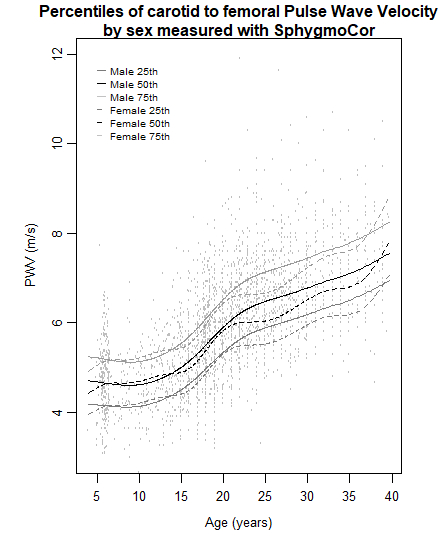Final ID: MDP1075
Developing normal values for pulse wave velocity in healthy young people
Abstract Body (Do not enter title and authors here): Background
A high prevalence of cardiovascular disease (CVD) globally prompts the necessity of a surrogate marker to identify CVD development at the subclinical stage. Observation of early alterations to the vasculature has proven to be beneficial in identifying adults who have an increased risk of CVD. Hence, utilizing vascular ageing as an effective, non-invasive, subclinical marker in assessing cardiovascular risk in young people could be promising for the reduction of CVD incidence. Pulse wave velocity (PWV) is a marker of vascular ageing, and even though the importance of PWV in cardiovascular health assessment in adults has been established, to use it routinely to evaluate young people at risk, normal values need to be determined. The Youth Vascular Consortium (YVC) is an international collaborative that was established to comprehensively investigate vascular ageing with a range of measures among young people. This study aimed to develop normal values for PWV measured by commonly used devices among healthy young people using data from the YVC.
Methods
This retrospective study included data on demographics, anthropometric, biochemical and vascular ageing measures collected from participants aged 1 to 40 years. Generalised additive models were used to derive percentile curves for the PWV data by age. Observed and predicted percentiles at years of age were reported by sex, geographical region and device.
Results
The YVC collected data on 36,973 participants from 24 countries across five different regions. Of these, 19,018 participants (mean age = 17 years, 51% female, 71% European) were classified as healthy based on their systolic and diastolic blood pressure, serum glucose, serum cholesterol and body mass index. Six devices were used to measure PWV (30% SphygmoCor). Device-specific percentile curves for PWV against age were constructed and an increasing trend in PWV was identified with age for both males and females.
Conclusion
This study provided normal values for PWV measured with six different devices for young people as age and sex-specific percentile curves. These curves may be applied clinically to identify young people with impaired vascular ageing and thus, those who may be at risk of overt CVD.
A high prevalence of cardiovascular disease (CVD) globally prompts the necessity of a surrogate marker to identify CVD development at the subclinical stage. Observation of early alterations to the vasculature has proven to be beneficial in identifying adults who have an increased risk of CVD. Hence, utilizing vascular ageing as an effective, non-invasive, subclinical marker in assessing cardiovascular risk in young people could be promising for the reduction of CVD incidence. Pulse wave velocity (PWV) is a marker of vascular ageing, and even though the importance of PWV in cardiovascular health assessment in adults has been established, to use it routinely to evaluate young people at risk, normal values need to be determined. The Youth Vascular Consortium (YVC) is an international collaborative that was established to comprehensively investigate vascular ageing with a range of measures among young people. This study aimed to develop normal values for PWV measured by commonly used devices among healthy young people using data from the YVC.
Methods
This retrospective study included data on demographics, anthropometric, biochemical and vascular ageing measures collected from participants aged 1 to 40 years. Generalised additive models were used to derive percentile curves for the PWV data by age. Observed and predicted percentiles at years of age were reported by sex, geographical region and device.
Results
The YVC collected data on 36,973 participants from 24 countries across five different regions. Of these, 19,018 participants (mean age = 17 years, 51% female, 71% European) were classified as healthy based on their systolic and diastolic blood pressure, serum glucose, serum cholesterol and body mass index. Six devices were used to measure PWV (30% SphygmoCor). Device-specific percentile curves for PWV against age were constructed and an increasing trend in PWV was identified with age for both males and females.
Conclusion
This study provided normal values for PWV measured with six different devices for young people as age and sex-specific percentile curves. These curves may be applied clinically to identify young people with impaired vascular ageing and thus, those who may be at risk of overt CVD.
More abstracts on this topic:
A peptoid derivative of alpha-calcitonin gene related peptide improves cardiac function in pressure-overload heart failure mice
Kumar Ambrish, Deloach Sarah, Dipette Donald, Potts Jay
Assessing low-density lipoprotein cholesterol (LDL-C) equations in childhood for long-term risk of cardiovascular disease events: Superior performance of the Sampson equationMeng Yaxing, Steinberger Julia, Urbina Elaine, Venn Alison, Viikari Jorma, Whitaker Kara, Woo Jessica, Raitakari Olli, Magnussen Costan, Wu Feitong, Juonala Markus, Jacobs David, Bazzano Lydia, Daniels Stephen, Dwyer Terence, Kahonen Mika, Sinaiko Alan

